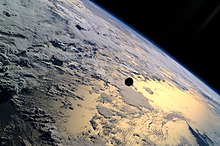
In telecommunications, direct-sequence spread spectrum (DSSS) is a spread-spectrum modulation technique primarily used to reduce overall signal interference. The direct-sequence modulation makes the transmitted signal wider in bandwidth than the information bandwidth. After the despreading or removal of the direct-sequence modulation in the receiver, the information bandwidth is restored, while the unintentional and intentional interference is substantially reduced.
AMSAT is a name for amateur radio satellite organizations worldwide, but in particular the Radio Amateur Satellite Corporation (AMSAT) with headquarters at Washington, D.C. AMSAT organizations design, build, arrange launches for, and then operate (command) satellites carrying amateur radio payloads, including the OSCAR series of satellites. Other informally affiliated national organizations exist, such as AMSAT Germany (AMSAT-DL) and AMSAT Japan (JAMSAT).

FalconSAT is the United States Air Force Academy's (USAFA) small satellite engineering program. Satellites are designed, built, tested, and operated by Academy cadets. The project is administered by the USAFA Space Systems Research Center under the direction of the Department of Astronautics. Most of the cadets who work on the project are pursuing a bachelor of science degree in astronautical engineering, although students from other disciplines join the project.

The STARSHINE series of three artificial satellites were student participatory missions sponsored by the United States Naval Research Laboratory.

SwissCube-1 is a Swiss satellite operated by École Polytechnique Fédérale de Lausanne (EPFL). The spacecraft is a single unit CubeSat, which was designed to conduct research into nightglow within the Earth's atmosphere, and to develop technology for future spacecraft. It has also been used for amateur radio. It was the first Swiss satellite to be launched.
USA-229, known before launch as NRO Launch 34 (NROL-34), is a pair of American signals intelligence satellites which were launched in 2011. They are operated by the United States National Reconnaissance Office.
An amateur radio satellite is an artificial satellite built and used by amateur radio operators. It forms part of the Amateur-satellite service. These satellites use amateur radio frequency allocations to facilitate communication between amateur radio stations.
Technology Education Satellite (TechEdSat) is a successful nano-sat flight series conducted from the NASA Ames Research Center in collaboration with numerous universities. While one of the principal aims has been to introduce young professionals and university students to the practical realm of developing space flight hardware, considerable innovations have been introduced. In addition, this evolving flight platform has tested concepts for Low Earth Orbit (LEO) sample return, as well as planetary nano-sat class mission concepts.
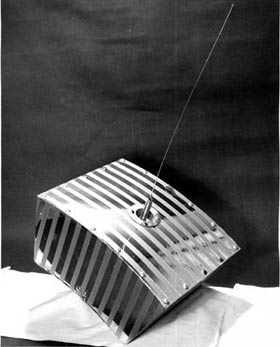
OSCAR II is the second amateur radio satellite launched by Project OSCAR into Low Earth orbit. OSCAR II was launched June 2, 1962, by a Thor-DM21 Agena B launcher from Vandenberg Air Force Base, Lompoc, California. The satellite, a rectangular box weighing 10 kg (22 lb), was launched as a secondary payload (ballast) for Corona 43, the fifth launch of a KH-4 satellite.

OSCAR 3 is the third amateur radio satellite launched by Project OSCAR into Low Earth Orbit. OSCAR 3 was launched March 9, 1965 by a Thor-DM21 Agena D launcher from Vandenberg Air Force Base, Lompoc, California. The satellite, massing 15 kg (33 lb), was launched piggyback with seven United States Air Force satellites. Though the satellite's active life was limited to sixteen days due to battery failure, OSCAR 3 relayed 176 messages from 98 stations in North America and Europe during its 274 orbit life-time -- the first amateur satellite to relay signals from Earth. As of 2023, it is still in orbit.

OSCAR IV was the fourth amateur radio satellite launched by Project OSCAR and the first targeted for Geostationary orbit on 12 December 1965. The satellite was launched piggyback with three United States Air Force satellites on a Titan IIIC launch vehicle. Due to a booster failure, OSCAR 4 was placed in an unplanned and largely unusable Geostationary transfer orbit.

OSCAR I is the first amateur radio satellite launched by Project OSCAR into low Earth orbit. OSCAR I was launched December 12, 1961, by a Thor-DM21 Agena B launcher from Vandenberg Air Force Base, Lompoc, California. The satellite, a rectangular box weighing 10 kg., was launched as a secondary payload (ballast) for Corona 9029, also known as Discoverer 36, the eighth and final launch of a KH-3 satellite.
BRICSat-P or OSCAR 83 (NO-83) previously known as PSat-B, is a U.S. technology demonstration satellite and an amateur radio satellite for Packet Radio. BRICSat-P is a low cost 1.5U CubeSat built by the U.S. Naval Academy Satellite Lab in collaboration with George Washington University, that will demonstrate on-orbit operation of a Micro-Cathode Arc Thruster (µCAT) electric propulsion system and carries an amateur communication payload.
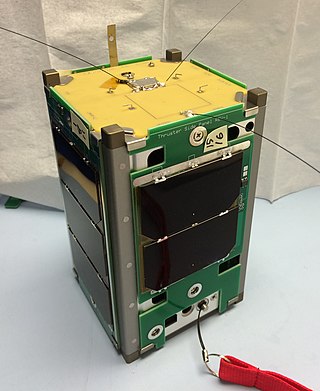
BRICSat-2, or USNAP1, was an experimental amateur radio satellite from the United States Naval Academy that was developed in collaboration with George Washington University. BRICSat-2 was the successor to BRICSat-P. AMSAT North America's OSCAR number administrator assigned number 103 to this satellite; in the amateur radio community it was therefore called Navy-OSCAR 103, short NO-103.
PSAT-2 is an experimental amateur radio satellite from the U.S. Naval Academy, which was developed in collaboration with the Technical University of Brno in Brno, Czech Republic. AMSAT North America's OSCAR number administrator assigned number 104 to this satellite; in the amateur radio community it is therefore also called Navy-OSCAR 104, short NO-104.
Weber-OSCAR 18 is an American amateur radio satellite.
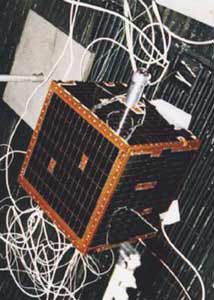
SEDSAT-1 is a U.S. amateur radio satellite built by students and developed at the University of Alabama in Huntsville (UAH).
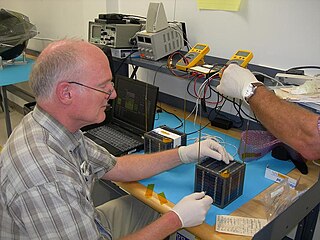
Radar Fence Transponder was an amateur radio satellite that was developed and built for training purposes at the United States Naval Academy. The 3 kg (6.6 lb) heavy RAFT had a cubic structure of 12.7 cm (5.0 in) edge length and therefore did not meet the Cubesat standard. Solar cells on all six sides of the satellite were used to supply energy. It had neither position control nor drive systems.
Sputnik 99 launched on April 2, 1999 from the Baikonur Cosmodrome on board a Soyuz-U-PVB launch vehicle. The nano-satellite was created in a joint-venture by Rosaviakosmos, Aéro-Club de France, and the Radio Amateur Satellite Corporation (AMSAT) as a marketing effort financially backed by The Swatch Group. Sputnik 99 was deployed from the Mir space station on April 16, 1999, even though its primary mission package, an amateur radio broadcast system (AR), had been purposely disabled, immediately rendering the satellite a piece of space flotsam.
Fox-1E, AO-109, Evolution or AMSAT OSCAR 109 is an American amateur radio satellite. It is a 1U Cubesat, was built by the AMSAT-NA and carries a single-channel transponder for FM radio. Fox-1E is the fifth amateur radio satellite of the Fox series of AMSAT North America.
